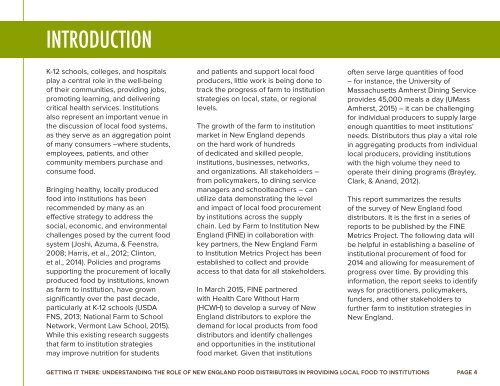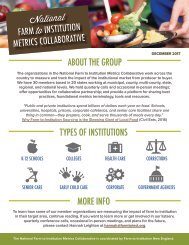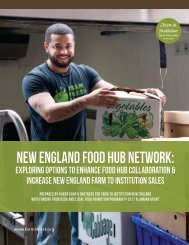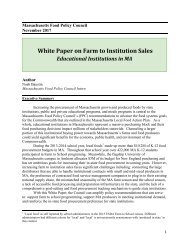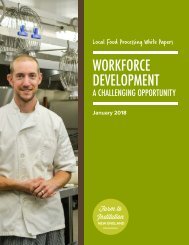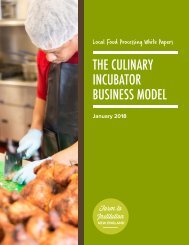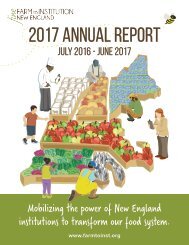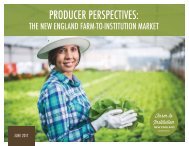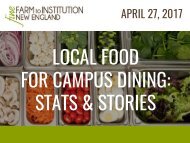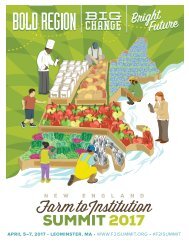FINE Distributor Report
“Getting it There: The Role of New England Food Distributors in Providing Local Food to Institutions” presents in-depth findings and makes specific, data-based recommendations for food distributors (including food hubs) as well as government officials, funders and institutions. The report is based on an original survey answered by over 60 food distributors across New England in the spring of 2015.
“Getting it There: The Role of New England Food Distributors in Providing Local Food to Institutions” presents in-depth findings and makes specific, data-based recommendations for food distributors (including food hubs) as well as government officials, funders and institutions. The report is based on an original survey answered by over 60 food distributors across New England in the spring of 2015.
Create successful ePaper yourself
Turn your PDF publications into a flip-book with our unique Google optimized e-Paper software.
INTRODUCTION<br />
K-12 schools, colleges, and hospitals<br />
play a central role in the well-being<br />
of their communities, providing jobs,<br />
promoting learning, and delivering<br />
critical health services. Institutions<br />
also represent an important venue in<br />
the discussion of local food systems,<br />
as they serve as an aggregation point<br />
of many consumers –where students,<br />
employees, patients, and other<br />
community members purchase and<br />
consume food.<br />
Bringing healthy, locally produced<br />
food into institutions has been<br />
recommended by many as an<br />
effective strategy to address the<br />
social, economic, and environmental<br />
challenges posed by the current food<br />
system (Joshi, Azuma, & Feenstra,<br />
2008; Harris, et al., 2012; Clinton,<br />
et al., 2014). Policies and programs<br />
supporting the procurement of locally<br />
produced food by institutions, known<br />
as farm to institution, have grown<br />
significantly over the past decade,<br />
particularly at K-12 schools (USDA<br />
FNS, 2013; National Farm to School<br />
Network, Vermont Law School, 2015).<br />
While this existing research suggests<br />
that farm to institution strategies<br />
may improve nutrition for students<br />
and patients and support local food<br />
producers, little work is being done to<br />
track the progress of farm to institution<br />
strategies on local, state, or regional<br />
levels.<br />
The growth of the farm to institution<br />
market in New England depends<br />
on the hard work of hundreds<br />
of dedicated and skilled people,<br />
institutions, businesses, networks,<br />
and organizations. All stakeholders –<br />
from policymakers, to dining service<br />
managers and schoolteachers – can<br />
utilize data demonstrating the level<br />
and impact of local food procurement<br />
by institutions across the supply<br />
chain. Led by Farm to Institution New<br />
England (<strong>FINE</strong>) in collaboration with<br />
key partners, the New England Farm<br />
to Institution Metrics Project has been<br />
established to collect and provide<br />
access to that data for all stakeholders.<br />
In March 2015, <strong>FINE</strong> partnered<br />
with Health Care Without Harm<br />
(HCWH) to develop a survey of New<br />
England distributors to explore the<br />
demand for local products from food<br />
distributors and identify challenges<br />
and opportunities in the institutional<br />
food market. Given that institutions<br />
often serve large quantities of food<br />
– for instance, the University of<br />
Massachusetts Amherst Dining Service<br />
provides 45,000 meals a day (UMass<br />
Amherst, 2015) – it can be challenging<br />
for individual producers to supply large<br />
enough quantities to meet institutions’<br />
needs. <strong>Distributor</strong>s thus play a vital role<br />
in aggregating products from individual<br />
local producers, providing institutions<br />
with the high volume they need to<br />
operate their dining programs (Brayley,<br />
Clark, & Anand, 2012).<br />
This report summarizes the results<br />
of the survey of New England food<br />
distributors. It is the first in a series of<br />
reports to be published by the <strong>FINE</strong><br />
Metrics Project. The following data will<br />
be helpful in establishing a baseline of<br />
institutional procurement of food for<br />
2014 and allowing for measurement of<br />
progress over time. By providing this<br />
information, the report seeks to identify<br />
ways for practitioners, policymakers,<br />
funders, and other stakeholders to<br />
further farm to institution strategies in<br />
New England.<br />
GETTING IT THERE: UNDERSTANDING THE ROLE OF NEW ENGLAND FOOD DISTRIBUTORS IN PROVIDING LOCAL FOOD TO INSTITUTIONS PAGE 4


